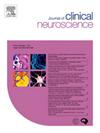Impact of perioperative cerebral blood flow evaluation using arterial spin labeling in a patient undergoing carotid artery stenting
IF 1.9
4区 医学
Q3 CLINICAL NEUROLOGY
引用次数: 0
Abstract
Background
Hyperperfusion syndrome (HPS) is one of the most serious complications after carotid artery stenting (CAS). Arterial spin labeling (ASL) is a noninvasive method for assessing cerebral perfusion. This study aimed to evaluate the utility of ASL compared to that of SPECT in evaluating changes in intracranial blood flow during the perioperative period of CAS.
Methods
We retrospectively reviewed prospectively collected data from 49 cases of CAS conducted for symptomatic and asymptomatic carotid artery stenosis. We calculated the relative cerebral blood flow (rCBF) from ASL (post labeling delay [PLD] of 1500 ms and 2500 ms) and SPECT, both pre- and post-CAS. Cerebrovascular reactivity (CVR) was assessed using SPECT with an acetazolamide challenge. We defined the change rate from PLD 1500 ms to 2500 ms before CAS as ΔrASL.
Results
Hyperperfusion phenomenon was observed in four cases (8.2 %), with one case (2.0 %) resulting in cerebral hemorrhage and diagnosed as HPS. Positive correlations were noted between ASL and SPECT at both pre- and post-CAS (r = 0.42–0.65, p < 0.01). A negative correlation was found between ΔrASL obtained from the two PLDs before CAS and CVR (r=-0.41, p < 0.01).
Conclusions
ASL using two PLDs is a useful method for evaluating changes in CBF during the perioperative period of CAS.
应用动脉自旋标记法评价颈动脉支架植入术患者围手术期脑血流的影响。
背景:高灌注综合征(HPS)是颈动脉支架置入术(CAS)后最严重的并发症之一。动脉自旋标记(ASL)是一种评估脑灌注的无创方法。本研究旨在评估 ASL 与 SPECT 相比在评估 CAS 围手术期颅内血流变化方面的实用性:方法: 我们回顾性分析了前瞻性收集的 49 例因无症状和无症状颈动脉狭窄而实施 CAS 的病例数据。我们通过 ASL(标记后延迟 [PLD] 为 1500 毫秒和 2500 毫秒)和 SPECT 计算了 CAS 术前和术后的相对脑血流量(rCBF)。脑血管反应性(CVR)通过使用乙酰唑胺挑战 SPECT 进行评估。我们将 CAS 前 1500 毫秒至 2500 毫秒的 PLD 变化率定义为 ΔrASL:结果:有四例(8.2%)观察到高灌注现象,其中一例(2.0%)导致脑出血,被诊断为 HPS。ASL和SPECT在CAS前后均呈正相关(r = 0.42-0.65,p 结论:ASL和SPECT在CAS前后均呈正相关(r = 0.42-0.65,p 结论:ASL和SPECT在CAS前后均呈正相关:使用两种 PLD 的 ASL 是评估 CAS 围手术期 CBF 变化的有效方法。
本文章由计算机程序翻译,如有差异,请以英文原文为准。
求助全文
约1分钟内获得全文
求助全文
来源期刊

Journal of Clinical Neuroscience
医学-临床神经学
CiteScore
4.50
自引率
0.00%
发文量
402
审稿时长
40 days
期刊介绍:
This International journal, Journal of Clinical Neuroscience, publishes articles on clinical neurosurgery and neurology and the related neurosciences such as neuro-pathology, neuro-radiology, neuro-ophthalmology and neuro-physiology.
The journal has a broad International perspective, and emphasises the advances occurring in Asia, the Pacific Rim region, Europe and North America. The Journal acts as a focus for publication of major clinical and laboratory research, as well as publishing solicited manuscripts on specific subjects from experts, case reports and other information of interest to clinicians working in the clinical neurosciences.
 求助内容:
求助内容: 应助结果提醒方式:
应助结果提醒方式:


